Related Research Articles

Packing problems are a class of optimization problems in mathematics that involve attempting to pack objects together into containers. The goal is to either pack a single container as densely as possible or pack all objects using as few containers as possible. Many of these problems can be related to real-life packaging, storage and transportation issues. Each packing problem has a dual covering problem, which asks how many of the same objects are required to completely cover every region of the container, where objects are allowed to overlap.

In geometry, a sphere packing is an arrangement of non-overlapping spheres within a containing space. The spheres considered are usually all of identical size, and the space is usually three-dimensional Euclidean space. However, sphere packing problems can be generalised to consider unequal spheres, spaces of other dimensions or to non-Euclidean spaces such as hyperbolic space.

In botany, phyllotaxis or phyllotaxy is the arrangement of leaves on a plant stem. Phyllotactic spirals form a distinctive class of patterns in nature.

A granular material is a conglomeration of discrete solid, macroscopic particles characterized by a loss of energy whenever the particles interact. The constituents that compose granular material are large enough such that they are not subject to thermal motion fluctuations. Thus, the lower size limit for grains in granular material is about 1 μm. On the upper size limit, the physics of granular materials may be applied to ice floes where the individual grains are icebergs and to asteroid belts of the Solar System with individual grains being asteroids.

Granular convection is a phenomenon where granular material subjected to shaking or vibration will exhibit circulation patterns similar to types of fluid convection. It is sometimes called the Brazil nut effect, when the largest of irregularly shaped particles end up on the surface of a granular material containing a mixture of variously sized objects. This name derives from the example of a typical container of mixed nuts, in which the largest will be Brazil nuts. The phenomenon is also known as the muesli effect since it is seen in packets of breakfast cereal containing particles of different sizes but similar density, such as muesli mix.

In geometry, a rhombic enneacontahedron is a polyhedron composed of 90 rhombic faces; with three, five, or six rhombi meeting at each vertex. It has 60 broad rhombi and 30 slim. The rhombic enneacontahedron is a zonohedron with a superficial resemblance to the rhombic triacontahedron.
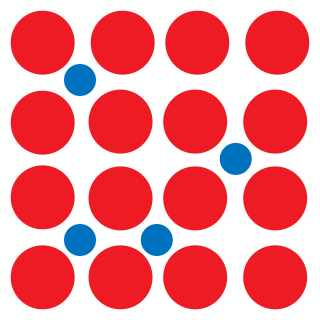
In materials science, an interstitial defect is a type of point crystallographic defect where an atom of the same or of a different type, occupies an interstitial site in the crystal structure. When the atom is of the same type as those already present they are known as a self-interstitial defect. Alternatively, small atoms in some crystals may occupy interstitial sites, such as hydrogen in palladium. Interstitials can be produced by bombarding a crystal with elementary particles having energy above the displacement threshold for that crystal, but they may also exist in small concentrations in thermodynamic equilibrium. The presence of interstitial defects can modify the physical and chemical properties of a material.
The percolation threshold is a mathematical concept in percolation theory that describes the formation of long-range connectivity in random systems. Below the threshold a giant connected component does not exist; while above it, there exists a giant component of the order of system size. In engineering and coffee making, percolation represents the flow of fluids through porous media, but in the mathematics and physics worlds it generally refers to simplified lattice models of random systems or networks (graphs), and the nature of the connectivity in them. The percolation threshold is the critical value of the occupation probability p, or more generally a critical surface for a group of parameters p1, p2, ..., such that infinite connectivity (percolation) first occurs.
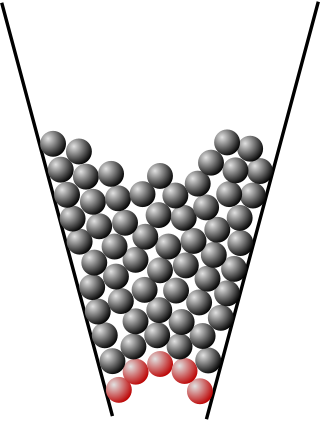
Jamming is the physical process by which the viscosity of some mesoscopic materials, such as granular materials, glasses, foams, polymers, emulsions, and other complex fluids, increases with increasing particle density. The jamming transition has been proposed as a new type of phase transition, with similarities to a glass transition but very different from the formation of crystalline solids.

In geometry, tetrahedron packing is the problem of arranging identical regular tetrahedra throughout three-dimensional space so as to fill the maximum possible fraction of space.

A colloidal crystal is an ordered array of colloid particles and fine grained materials analogous to a standard crystal whose repeating subunits are atoms or molecules. A natural example of this phenomenon can be found in the gem opal, where spheres of silica assume a close-packed locally periodic structure under moderate compression. Bulk properties of a colloidal crystal depend on composition, particle size, packing arrangement, and degree of regularity. Applications include photonics, materials processing, and the study of self-assembly and phase transitions.

The smoothed octagon is a region in the plane found by Karl Reinhardt in 1934 and conjectured by him to have the lowest maximum packing density of the plane of all centrally symmetric convex shapes. It was also independently discovered by Kurt Mahler in 1947. It is constructed by replacing the corners of a regular octagon with a section of a hyperbola that is tangent to the two sides adjacent to the corner and asymptotic to the sides adjacent to these.
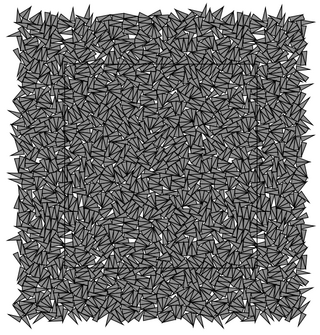
Lubachevsky-Stillinger (compression) algorithm is a numerical procedure suggested by F. H. Stillinger and B.D. Lubachevsky that simulates or imitates a physical process of compressing an assembly of hard particles. As the LSA may need thousands of arithmetic operations even for a few particles, it is usually carried out on a computer.

Salvatore Torquato is an American theoretical scientist born in Falerna, Italy. His research work has impacted a variety of fields, including physics, chemistry, applied and pure mathematics, materials science, engineering, and biological physics. He is the Lewis Bernard Professor of Natural Sciences in the Department of Chemistry and Princeton Institute for the Science and Technology of Materials at Princeton University. He has been a Senior Faculty Fellow in the Princeton Center for Theoretical Science, an enterprise dedicated to exploring frontiers across the theoretical natural sciences. He is also an Associated Faculty Member in three departments or programs at Princeton University: Physics, Program in Applied and Computational Mathematics, and Mechanical & Aerospace Engineering. On multiple occasions, he was a Member of the School of Mathematics as well as the School of Natural Sciences at the Institute for Advanced Study, Princeton, New Jersey.
Ulam's packing conjecture, named for Stanislaw Ulam, is a conjecture about the highest possible packing density of identical convex solids in three-dimensional Euclidean space. The conjecture says that the optimal density for packing congruent spheres is smaller than that for any other convex body. That is, according to the conjecture, the ball is the convex solid which forces the largest fraction of space to remain empty in its optimal packing structure. This conjecture is therefore related to the Kepler conjecture about sphere packing. Since the solution to the Kepler conjecture establishes that identical balls must leave ≈25.95% of the space empty, Ulam's conjecture is equivalent to the statement that no other convex solid forces that much space to be left empty.
Hyperuniform materials are mixed-component many-particle systems with unusually low fluctuations in component density at large scales, when compared to the distribution of constituents in common disordered systems, like a mixed ideal gas (air) or typical liquids or amorphous solids: A disordered hyperuniform system is statistically isotropic, like a liquid, but exhibits reduced long-wavelength density fluctuations, similar to crystals.
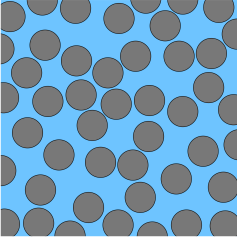
Random sequential adsorption (RSA) refers to a process where particles are randomly introduced in a system, and if they do not overlap any previously adsorbed particle, they adsorb and remain fixed for the rest of the process. RSA can be carried out in computer simulation, in a mathematical analysis, or in experiments. It was first studied by one-dimensional models: the attachment of pendant groups in a polymer chain by Paul Flory, and the car-parking problem by Alfréd Rényi. Other early works include those of Benjamin Widom. In two and higher dimensions many systems have been studied by computer simulation, including in 2d, disks, randomly oriented squares and rectangles, aligned squares and rectangles, various other shapes, etc.
Alessio Zaccone is an Italian physicist.
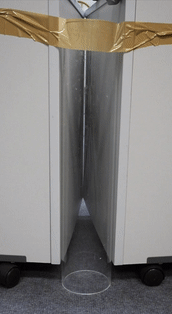
Sphere packing in a cylinder is a three-dimensional packing problem with the objective of packing a given number of identical spheres inside a cylinder of specified diameter and length. For cylinders with diameters on the same order of magnitude as the spheres, such packings result in what are called columnar structures.
Dov I. Levine is an American-Israeli physicist, known for his research on quasicrystals, soft condensed matter physics, and statistical mechanics out of equilibrium.
References
- ↑ Torquato, S.; Truskett, T.M.; Debenedetti, P.G. (2000). "Is Random Close Packing of Spheres Well Defined?". Physical Review Letters. 84 (10): 2064–2067. arXiv: cond-mat/0003416 . Bibcode:2000PhRvL..84.2064T. doi:10.1103/PhysRevLett.84.2064. PMID 11017210. S2CID 13149645.
- ↑ Modes of wall induced granular crystallisation in vibrational packing.Granular Matter, 21(2), 26
- ↑ Blumenfeld, Raphael (2021-09-09). "Disorder Criterion and Explicit Solution for the Disc Random Packing Problem". Physical Review Letters. 127 (11): 118002. arXiv: 2106.11774 . Bibcode:2021PhRvL.127k8002B. doi:10.1103/physrevlett.127.118002. ISSN 0031-9007. PMID 34558936. S2CID 237617506.
- ↑ Zaccone, Alessio (2022). "Explicit Analytical Solution for Random Close Packing in d=2 and d=3". Physical Review Letters. 128 (2): 028002. arXiv: 2201.04541 . Bibcode:2022PhRvL.128b8002Z. doi:10.1103/PhysRevLett.128.028002. PMID 35089741. S2CID 245877616.
- ↑ Weisstein, Eric W. "Random Close Packing". MathWorld .
- ↑ Likos, Christos (2022). "Maximizing space efficiency without order, analytically". Journal Club for Condensed Matter Physics. doi: 10.36471/JCCM_March_2022_02 . S2CID 247914694.
- ↑ Rosato, Anthony D.; Dybenko, Oleksandr; Horntrop, David J.; Ratnaswamy, Vishagan; Kondic, Lou (2010). "Microstructure Evolution in Density Relaxation by Tapping". Physical Review E. 81 (6): 061301. Bibcode:2010PhRvE..81f1301R. doi:10.1103/physreve.81.061301. PMID 20866410.
- ↑ Ratnaswamy, V.; Rosato, A.D.; Blackmore, D.; Tricoche, X.; Ching, Luo; Zuo, L. (2012). "Evolution of Solids Fraction Surfaces in Tapping: Simulation and Dynamical Systems Analysis". Granular Matter. 14 (2): 163–68. doi:10.1007/s10035-012-0343-2. S2CID 254114944.
- ↑ Donev, A.; Cisse, I.; Sachs, D.; Variano, E. A.; Stillinger, F. H.; Connelly, R.; Torquato, S.; Chaikin, P. M. (2004). "Improving the Density of Jammed Disordered Packings Using Ellipsoids". Science. 303 (5660): 990–993. Bibcode:2004Sci...303..990D. CiteSeerX 10.1.1.220.1156 . doi:10.1126/science.1093010. PMID 14963324. S2CID 33409855.
- ↑ Dullien, F. A. L. (1992). Porous Media: Fluid Transport and Pore Structure (2nd ed.). Academic Press. ISBN 978-0-12-223651-8.
- Jaeger, H. M.; Nagel, S. R. (1992). "Physics of Granular States". Science. 255 (5051): 1523–31. Bibcode:1992Sci...255.1523J. doi:10.1126/science.255.5051.1523. PMID 17820163. S2CID 44568820.
- Donev, A.; Cisse, Ibrahim; Sachs, David; Variano, Evan A.; Stillinger, Frank H.; Connelly, Robert; Torquato, Salvatore; Chaikin, P. M. (2004). "Improving the Density of Jammed Disordered Packings using Ellipsoids". Science. 303 (5660): 990–993. Bibcode:2004Sci...303..990D. CiteSeerX 10.1.1.220.1156 . doi:10.1126/science.1093010. PMID 14963324. S2CID 33409855.